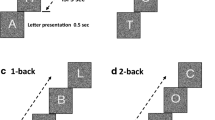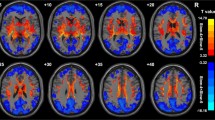Abstract
Gamma band oscillations participate in the temporal binding needed to synchronize cortical networks, involved in early sensory and short term memory processes. In earlier studies, alterations of these neurophysiological parameters have been found in psychotic disorders. To date no study has explored the temporal dynamics and signal complexity of gamma band oscillations in first episode psychosis (FEP). To address this issue, gamma band analysis was performed in 15 FEP patients and 18 healthy controls who successfully performed an adapted 2-back working memory task. Multiple linear and logistic regression models were computed to explore the relationship between the cognitive status and gamma oscillation changes over time. Based on regression model results, phase diagrams were constructed and their complexity was estimated using fractal dimension, a mathematical tool that describes shapes as numeric values. When adjusted for gamma values at time lags −3 to −4 ms and −15 to −16 ms, FEP patients displayed significantly higher time-dependent changes than controls, independently of the nature of the task. The present results are consistent with a discoordination of the activity of cortical generators engaged by the stimulus apparition in FEP patients, leading to a global binding deficit. In addition, fractal analysis showing higher complexity of gamma signal, confirmed this deficit. Our results provide evidence for recruitment of supplementary cortical generators as compensating mechanisms and yield further understanding for the pathophysiology cognitive impairments in FEP.



Similar content being viewed by others

References
Albe-Fessard D, Tasker R, Yamashiro K, Chodakiewitz J, Dostrovsky J (1986) Comparison in man of short latency averaged evoked potentials recorded in thalamic and scalp hand zones of representation. Electroencephalogr Clin Neurophysiol 65:405–415
Allison T, McCarthy G, Wood CC, Jones SJ (1991) Potentials evoked in human and monkey cerebral cortex by stimulation of the median nerve. A review of scalp and intracranial recordings. Brain 114(Pt 6):2465–2503
Babiloni F, Babiloni C, Carducci F, Fattorini L, Onorati P, Urbano A (1996) Spline Laplacian estimate of EEG potentials over a realistic magnetic resonance-constructed scalp surface model. Electroencephalogr Clin Neurophysiol 98:363–373
Basar E (2013) Brain oscillations in neuropsychiatric disease. Dialogues Clin Neurosci 15:291–300
Basar E, Guntekin B (2013) Review of delta, theta, alpha, beta, and gamma response oscillations in neuropsychiatric disorders. Suppl Clin Neurophysiol 62:303–341
Basar-Eroglu C, Brand A, Hildebrandt H, Karolina Kedzior K, Mathes B, Schmiedt C (2007) Working memory related gamma oscillations in schizophrenia patients. Int J Psychophysiol 64:39–45
Bertrand O, Tallon-Baudry C (2000) Oscillatory gamma activity in humans: a possible role for object representation. Int J Psychophysiol 38:211–223
Buzsaki G, Wang XJ (2012) Mechanisms of gamma oscillations. Annu Rev Neurosci 35:203–225
Dwyer J, Feinleib M (1992) Introduction to statistical models for longitudinal observation. In: Dwyer JH et al (eds) Statistical models for longitudinal studies of health. Oxford University Press, New York, pp 3–47
Glahn DC, Laird AR, Ellison-Wright I, Thelen SM, Robinson JL, Lancaster JL, Bullmore E, Fox PT (2008) Meta-analysis of gray matter anomalies in schizophrenia: application of anatomic likelihood estimation and network analysis. Biol Psychiatry 64:774–781
Homan RW, Herman J, Purdy P (1987) Cerebral location of international 10–20 system electrode placement. Electroencephalogr Clin Neurophysiol 66:376–382
Insel TR (2010) Rethinking schizophrenia. Nature 468:187–193
Joliot M, Ribary U, Llinas R (1994) Human oscillatory brain activity near 40 Hz coexists with cognitive temporal binding. Proc Natl Acad Sci USA 91:11748–11751
Jung TP, Makeig S, Humphries C, Lee TW, McKeown MJ, Iragui V, Sejnowski TJ (2000) Removing electroencephalographic artifacts by blind source separation. Psychophysiology 37:163–178
Kahn RS, Sommer IE, Murray RM, Meyer-Lindenberg A, Weinberger DR, Cannon TD, O’Donovan M, Correll CU, Kane JM, van Os J, Insel TR (2015) Schizophrenia. Nat Rev Dis Prim 1:15067
Lee KH, Williams LM, Haig A, Gordon E (2003) “Gamma (40 Hz) phase synchronicity” and symptom dimensions in schizophrenia. Cogn Neuropsychiatry 8:57–71
Leicht G, Andreou C, Polomac N, Lanig C, Schöttle D, Lambert M, Mulert C (2015) Reduced auditory evoked gamma band response and cognitive processing deficits in first episode schizophrenia. World J Biol Psychiatry 16:1–16
Llinas R (2003) Consciousness and the thalamocortical loop. Int Congr Ser 1250:409–416
Llinas R, Ribary U (1993) Coherent 40-Hz oscillation characterizes dream state in humans. Proc Natl Acad Sci USA 90:2078–2081
Llinas R, Ribary U (2001) Consciousness and the brain. The thalamocortical dialogue in health and disease. Ann N Y Acad Sci 929:166–175
Llinas RR, Ribary U, Jeanmonod D, Kronberg E, Mitra PP (1999) Thalamocortical dysrhythmia: a neurological and neuropsychiatric syndrome characterized by magnetoencephalography. Proc Natl Acad Sci USA 96:15222–15227
Llinas R, Urbano FJ, Leznik E, Ramirez RR, van Marle HJ (2005) Rhythmic and dysrhythmic thalamocortical dynamics: GABA systems and the edge effect. Trends Neurosci 28:325–333
Milliken GA, Johnson DE (1994) Analysis of messy data, Vol I: Designed experiments. Chapman and Hall/CRC Press, Boca Raton, FL
Missonnier P, Herrmann FR, Michon A, Fazio-Costa L, Gold G, Giannakopoulos P (2010) Early disturbances of gamma band dynamics in mild cognitive impairment. J Neural Transm 117:489–498
Missonnier P, Herrmann FR, Zanello A, Badan Ba M, Curtis L, Canovas D, Chantraine F, Richiardi J, Giannakopoulos P, Merlo MC (2012) Event-related potentials and changes of brain rhythm oscillations during working memory activation in patients with first-episode psychosis. J Psychiatry Neurosci 37:95–105
Missonnier P, Hasler R, Perroud N, Herrmann FR, Millet P, Richiardi J, Malafosse A, Giannakopoulos P, Baud P (2013) EEG anomalies in adult ADHD subjects performing a working memory task. Neuroscience 241:135–146
Pantev C, Makeig S, Hoke M, Galambos R, Hampson S, Gallen C (1991) Human auditory evoked gamma-band magnetic fields. Proc Natl Acad Sci USA 88:8996–9000
Perez V, Roach B, Woods S, Srihari V, McGlashan T, Ford J, Mathalon D (2013) Early auditory gamma-band responses in patients at clinical high risk for schizophrenia. Suppl Clin Neurophysiol 62:147–162
Perrin F, Bertrand O, Pernier J (1987) Scalp current density mapping: value and estimation from potential data. IEEE Trans Biomed Eng 34:283–288
Pittman-Polletta BR, Kocsis B, Vijayan S, Whittington MA, Kopell NJ (2015) Brain rhythms connect impaired inhibition to altered cognition in schizophrenia. Biol Psychiatry 77:1020–1030
Reichenberg A, Harvey PD, Bowie CR, Mojtabai R, Rabinowitz J, Heaton RK, Bromet E (2009) Neuropsychological function and dysfunction in schizophrenia and psychotic affective disorders. Schizophr Bull 35:1022–1029
Ribary U (2005) Dynamics of thalamo-cortical network oscillations and human perception. Prog Brain Res 150:127–142
Ribary U, Ioannides AA, Singh KD, Hasson R, Bolton JP, Lado F, Mogilner A, Llinas R (1991) Magnetic field tomography of coherent thalamocortical 40-Hz oscillations in humans. Proc Natl Acad Sci USA 88:11037–11041
Roach BJ, Mathalon DH (2008) Event-related EEG time-frequency analysis: an overview of measures and an analysis of early gamma band phase locking in schizophrenia. Schizophr Bull 34:907–926
Roach BJ, Ford JM, Hoffman RE, Mathalon DH (2013) Converging evidence for gamma synchrony deficits in schizophrenia. Suppl Clin Neurophysiol 62:163–180
Rothenberger A (2009) Brain oscillations forever—neurophysiology in future research of child psychiatric problems. J Child Psychol Psychiatry 50:79–86
Shenton ME, Dickey CC, Frumin M, McCarley RW (2001) A review of MRI findings in schizophrenia. Schizophr Res 49:1–52
Singer W (1999) Neuronal synchrony: a versatile code for the definition of relations? Neuron 24(49–65):111–125
Singer W (2001) Consciousness and the binding problem. Ann N Y Acad Sci 929:123–146
Singer W (2009) Distributed processing and temporal codes in neuronal networks. Cogn Neurodyn 3:189–196
Skåtun KC, Kaufmann T, Tønnesen S, Biele G, Melle I, Agartz I, Alnæs D, Andreassen OA, Westlye LT (2016) Global brain connectivity alterations in patients with schizophrenia and bipolar spectrum disorders. J Psychiatry Neurosci 41:331–341
Spencer KM, Nestor PG, Perlmutter R, Niznikiewicz MA, Klump MC, Frumin M, Shenton ME, McCarley RW (2004) Neural synchrony indexes disordered perception and cognition in schizophrenia. Proc Natl Acad Sci USA 101:17288–17293
Spencer KM, Niznikiewicz MA, Shenton ME, McCarley RW (2008) Sensory-evoked gamma oscillations in chronic schizophrenia. Biol Psychiatry 63:744–747
Stam CJ (2005) Nonlinear dynamical analysis of EEG and MEG: review of an emerging field. Clin Neurophysiol 116:2266–2301
Steriade M (2006) Grouping of brain rhythms in corticothalamic systems. Neuroscience 137:1087–1106
Symond MP, Harris AW, Gordon E, Williams LM (2005) “Gamma synchrony” in first-episode schizophrenia: a disorder of temporal connectivity? Am J Psychiatry 162:459–465
Uhlhaas PJ (2013) Dysconnectivity, large-scale networks and neuronal dynamics in schizophrenia. Curr Opin Neurobiol 23:283–290
Uhlhaas PJ, Singer W (2010) Abnormal neural oscillations and synchrony in schizophrenia. Nat Rev Neurosci 11:100–113
Uhlhaas PJ, Singer W (2011) The development of neural synchrony and large-scale cortical networks during adolescence: relevance for the pathophysiology of schizophrenia and neurodevelopmental hypothesis. Schizophr Bull 37:514–523
Uhlhaas PJ, Singer W (2012) Neuronal dynamics and neuropsychiatric disorders: toward a translational paradigm for dysfunctional large-scale networks. Neuron 75:963–980
Uhlhaas PJ, Haenschel C, Nikolić D, Singer W (2008) The role of oscillations and synchrony in cortical networks and their putative relevance for the pathophysiology of schizophrenia. Schizophr Bull 34:927–943
Uhlhaas PJ, Roux F, Rodriguez E, Rotarska-Jagiela A, Singer W (2010) Neural synchrony and the development of cortical networks. Trends Cogn Sci 14:72–80
Uhlhaas PJ, Roux F, Singer W (2013) Thalamocortical synchronization and cognition: implications for schizophrenia? Neuron 77:997–999
Varela F, Lachaux JP, Rodriguez E, Martinerie J (2001) The brainweb: phase synchronization and large-scale integration. Nat Rev Neurosci 2:229–239
Ventura J, Green MF, Shaner A, Liberman RP (1993) Training and Quality Assurance with the Brief Psychiatric Rating-Scale—the Drift Busters. Int J Meth Psych Res 3:221–244
Ventura J, Nuechterlein KH, Subotnik KL, Gutkind D, Gilbert EA (2000) Symptom dimensions in recent-onset schizophrenia and mania: a principal components analysis of the 24-item Brief Psychiatric Rating Scale. Psychiatry Res 97:129–135
Wagner G, Koch K, Schachtzabel C, Schultz CC, Gaser C, Reichenbach JR, Sauer H, Bar KJ, Schlosser RG (2013) Structural basis of the fronto-thalamic disconnectivity in schizophrenia: A combined DCM-VBM study. Neuroimage Clin 3:95–105
Ward LM (2011) The thalamic dynamic core theory of conscious experience. Conscious Cogn 20:464–486
Welsh RC, Chen AC, Taylor SF (2010) Low-frequency BOLD fluctuations demonstrate altered thalamocortical connectivity in schizophrenia. Schizophr Bull 36:713–722
Woodward ND (2016) The course of neuropsychological impairment and brain structure abnormalities in psychotic disorders. Neurosci Res 102:39–46
Woodward ND, Karbasforoushan H, Heckers S (2012) Thalamocortical dysconnectivity in schizophrenia. Am J Psychiatry 169:1092–1099
Xing D, Shen Y, Burns S, Yeh CI, Shapley R, Li W (2012) Stochastic generation of gamma-band activity in primary visual cortex of awake and anesthetized monkeys. J Neurosci 32:13873a–13880a
Acknowledgements
The authors wish to gratefully thank Prof. A. Prévot for vigilant proofreading of the manuscript.
Author information
Authors and Affiliations
Corresponding author
Ethics declarations
Conflict of interest
This study has not been submitted elsewhere for publication, in whole or in part, and all the authors listed have approved the manuscript. The authors declare that there are no actual or potential conflicts of interest.
Rights and permissions
About this article
Cite this article
Missonnier, P., Curtis, L., Ventura, J. et al. Differences of temporal dynamics and signal complexity of gamma band oscillations in first-episode psychosis during a working memory task. J Neural Transm 124, 853–862 (2017). https://doi.org/10.1007/s00702-017-1728-5
Received:
Accepted:
Published:
Issue Date:
DOI: https://doi.org/10.1007/s00702-017-1728-5



